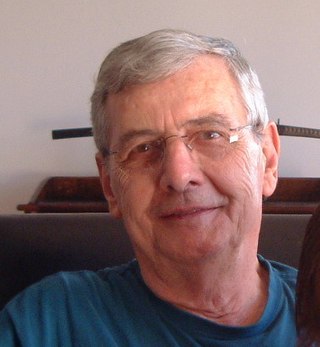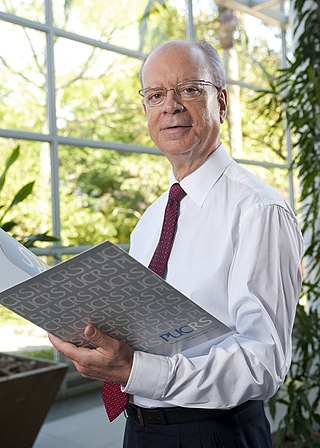
Porto Alegre is the capital and largest city of the Brazilian state of Rio Grande do Sul. Its population of 1.3 million inhabitants (2022) makes it the 11th-most populous city in the country and the center of Brazil's fifth-largest metropolitan area, with 4.4 million inhabitants (2010). The city is the southernmost capital city of a Brazilian state.

The Federal University of Rio Grande do Sul is a Brazilian public federal research university based in Porto Alegre, Rio Grande do Sul. UFRGS is among the largest and highest-rated universities in Brazil, having one of the largest number of scientific publications. From 2012 to 2019, the university was elected as the best federal university of Brazil. UFRGS has over 31,000 undergraduate students, over 12,000 graduate students, and more than 2,600 faculty members. As a Brazilian public federal institution, students do not pay tuition fees to enroll in courses offered by the university.

Science and technology in Brazil has entered the international arena in recent decades. The central agency for science and technology in Brazil is the Ministry of Science and Technology, which includes the CNPq and Finep. This ministry also has a direct supervision over the National Institute for Space Research, the National Institute of Amazonian Research, and the National Institute of Technology (Brazil). The ministry is also responsible for the Secretariat for Computer and Automation Policy, which is the successor of the SEI. The Ministry of Science and Technology, which the Sarney government created in March 1985, was headed initially by a person associated with the nationalist ideologies of the past. Although the new minister was able to raise the budget for the science and technology sector, he remained isolated within the government and had no influence on policy making for the economy.

The Federal University of Santa Maria is a Brazilian public university located in Santa Maria, in the state of Rio Grande do Sul, funded by the federal government of Brazil. It was founded in 1960, by Professor José Mariano da Rocha Filho. Its campuses span over 1,837.72 ha, with a total of 386,968 m2 of buildings and 28,307 students.

The Jacuí River is a river in Rio Grande do Sul state of southern Brazil. The Jacuí empties into the Guaíba River, an estuarine arm of the Lagoa dos Patos, a large coastal lagoon connected to the Atlantic Ocean.
The University of São Tomé and Príncipe, USTP, is a public institution of higher education in São Tomé and Príncipe. It is the main institution dedicated to teaching, research and university extension of the country. It was established in 2014 by merging three older institutions of higher education: ISP, EFOPE and ICS.

Carlos Roberto Velho Cirne Lima, also referred to as Carlos Cirne Lima, was a Brazilian contemporary dialectical philosopher.

The PUCRS Museum of Science and Technology is a Brazilian museum run by the Pontifical Catholic University of Rio Grande do Sul (PUCRS), located in the city of Porto Alegre in Rio Grande do Sul, at Ipiranga Av. 6681, Building 40, Parthenon. Visiting hours are from 9am to 5pm Tuesday to Friday and 10am to 6pm during the weekend.

The SBTVD Forum is a non-profit organization of private and public companies responsible for the general aspects of Digital TV deployment in Brazil. The organization was founded in 2007 in order to address all technical issues regarding the upcoming SBTVD standard, also known as ISDB-Tb.

The economy of Porto Alegre is the fastest growing economy in Brazil and is currently the country's 7th largest regional economy. The city of Porto Alegre has a population of approximately 1.4 million people. The history of Porto Alegre, particularly during the industrial revolution established its economy and the basis of the current industrial sector in the city.
Banhados do Delta do Jacuí Biological Reserve is a biological reserve in the Jacuí River delta in Rio Grande do Sul, Brazil.

The Pontifical Catholic University of Paraná is a private, not-for-profit Catholic university. The main campus is located in Curitiba, the capital city of the State of Paraná, Brazil. There are four additional campuses located in the cities of Londrina, Maringá, São José dos Pinhais and Toledo. It is maintained by APC, an organization run by Marist Brothers. The Catholic Archbishop of the city of Curitiba is the ceremonial chancellor of the university.

The Universidade Feevale (Feevale) is a Brazilian university in the city of Novo Hamburgo in the metropolitan region of Porto Alegre, Rio Grande do Sul. The selection process is through an entrance exam and continuous assessment.
Tarairiú (Caratiú) is an language of eastern Brazil. The Tarairiú Nation was divided into several etnies: the Janduí, Kanindé, Payakú, Jenipapo, Jenipapo-Kanindé, Javó, Kamaçu, Takarijú, Ariús, Pêgas, Caratiús, Coremas, Panatís, Paratiós, Piancós, Xukurú among others.

The Central Library Brother José Otão is the main library of Pontifícia Universidade Católica do Rio Grande do Sul (PUCRS), located in Porto Alegre, Brazil.

Joaquim Clotet Martí holds a doctorate in Philosophy and Letters, with outstanding work in the area of Ethics and Bioethics. Since 2004, he has been the President of the Pontifícia Universidade Católica do Rio Grande do Sul (PUCRS), Porto Alegre, Brazil.

Aldyr Garcia Schlee was a Brazilian writer, journalist, translator, illustrator, and professor.

Arroio Dilúvio is a brook (arroio) in Porto Alegre, Rio Grande do Sul, Brazil, that flows in areas with high population density. It was or still is known by other names: Riacho Ipiranga, Arroio da Azenha, Riacho or Riachinho and even Arroio do Sabão, this being the current name of the stream that gives it its most distant source.
















